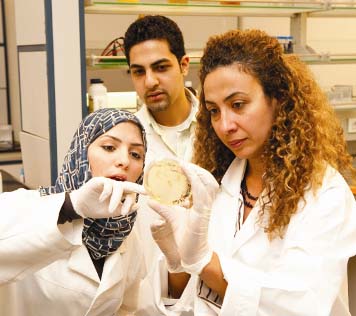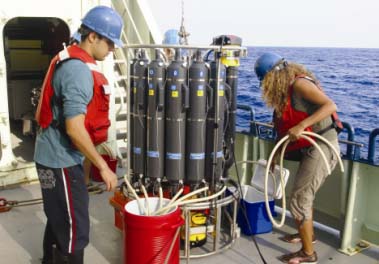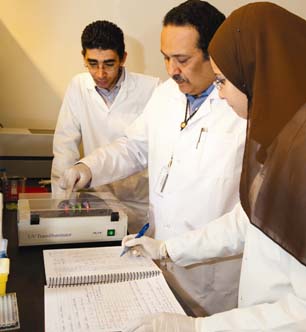| |
CUTTING-EDGE
CURE
AUC’s biotechnology
graduate
students
are
researching
medications
for
viral infections
and
genetic
diseases
in Egypt
|
| |
Azzazy and Sherif Shawky, a doctoral student with the biotechnology group at the Yousef Jameel Science and Technology Research Center,
examine the color signals generated by gold nanoparticles used to develop sensitive tests for direct detection of hepatitis C virus in human serum |
| |
Wearing a white coat and sterile gloves,Ahmed Shibl, biotechnology graduate student, sat in the biology department’s laboratory preparing samples of bacteria for DNA amplification with the lab’s new thermal cycler machine. His hand was steady, his gaze intensely focusing on dropping correct amounts of the mixture into tubes.
Shibl is one of 52 students enrolled in AUC’s biotechnology graduate program, which started in Fall 2007. Students and faculty members are working on an array of projects, including developing treatment options for hepatitis C and other illnesses that include cancer, genetic diseases and influenza.The program is taking an innovative approach by focusing its research on the distinctive needs of people in Egypt and the Middle East.
 |
Siam and biotechnology graduate students Ghada Mostafa and Ahmed
Shibl discuss cloning results in the biology department laboratory |
From the Lab to the Real World
Utilizing the university’s high-tech facilities, particularly the Yousef Jameel Science and Technology Research Center,AUC’s biotechnology researchers are finding real-world applications for their projects, enabling them to address crucial issues in the fields of pharmaceutics, diagnostics, agriculture and the environment. One such project was conducted by Shibl and Rania Siam, associate professor of biology and director of AUC’s biotechnology graduate program, who both lived and worked in the Red Sea for two weeks on the Woods Hole Oceanographic Institute scientific research vessel, Oceanus.The AUC researchers, working as part of a larger international collaborative research expedition, aimed to identify bacteria with potential anti-microbial properties that live in brine pools 2,300 meters beneath the water’s surface with temperatures up to 70 degrees Celsius. This is part of a drug discovery project for the identification of new compounds with potential biotechnological applications.
“The environmental genomic project of the Red Sea is one of the few research projects in the region that will have an environmental, biological, biotechnology and pharmaceutical impact,” explained Siam.“It exposes our students to contemporary science and technologies and allows them to utilize cutting-edge experimental and analytical tools in several interdisciplinary fields such as marine biotechnology, genomics and bioinformatics.”
For Shibl, the experience provided a unique learning opportunity.“It was very educational for me because there is no other way I would have dealt with such sophisticated sampling and filtering equipment except through this project,” he said.“I also met scientists from different countries and was exposed to new types of experiments.”
|
| |
 |
Shibl and Siam on board the research vessel Oceanus (owned by the National Science Foundation and operated by Woods Hole Oceanographic Institute), as part of the scientific
crew on the Red Sea genomics AUC-KAUST collaborative research project
|
Fighting the Virus
With hepatitis C, faculty members and students are working to develop ultra-sensitive, low-cost testing for the disease and are using the latest research in genomics and bioinformatics to understand how the virus mutates.They are also working on treatment options, trying to identify how to target the delivery of hepatitis C medicine
straight to the liver.“There has been a lot of work done in genomics, but most of it deals with strains
of the disease and genotypes that we don’t see in Egypt,” said Hassan Azzazy, chair of the chemistry department.
Other work includes research into genetic predisposition to infection and cancer, and mapping the genome of influenza to develop a long-term vaccine instead of the current yearly injection.“The flu virus mutates every year,” explained Siam.“We have identified conserved [non-mutated] regions in the virus and are now targeting those regions of influenza with a revolutionary drug that can eliminate not just avian, but swine and seasonal influenza as well.”
Students are also working directly with international specialists at the U.S. Naval Medical Research Unit-3 on infectious diseases.They are involved in sequencing the genome of avian and swine influenza strains in Egypt. Other students are researching diarrheal pandemics caused by bacteria such as vibrio cholerae, which kills children due to dehydration.
“These studies have inherent value for the country,” explained Siam.“The majority of vaccines currently administered are designed in Europe or North America against the bacterial strains in these regions.Therefore, assessing the predominant bacterial strains contributing to diseases in Egypt will allow the design of effective vaccines and appropriate treatment strategies that will decrease the regional disease burden.”
|
| |
 |
Azzazy, Shawky and Mansour discuss the signals generated by different colored nanocrystals that are used to label biological molecules such as antibodies and nucleic acids for the development of ultrasensitive diagnostic tests for infectious agents and other disease markers
|
Professional Partnerships
Besides the technical expertise, the program emphasizes increased collaboration with the biotechnology industry, giving students the chance to work and train in biotechnology firms in Egypt. In addition,AUC is collaborating with the King Abdullah University of Science and Technology, a world-class graduate-level research university in Saudi Arabia.The partnership involves establishing a genomic facility at AUC, which would help researchers isolate bacterial genomes, sequence their DNA and map the microbes for the discovery of biotechnological and pharmaceutical products.
“One milliliter of seawater contains around 1 million bacteria, but so far we have only identified 1 or 2 percent of the total,” said Hamza El Dorry, chair of the biology department, adding that having such a facility at AUC would enable the university to exchange information and findings with the local and international scientific communities.
Because of its interdisciplinary nature, the program prepares its graduates to be industry leaders in the field of biotechnology.“We did not start this program to graduate another batch of technicians,” said Azzazy, explaining that the goal of the program is to train students in three areas: basic sciences, biotechnology applications and entrepreneurship.“We need leaders who can spot an opportunity, form teams, form companies, understand ethics and patent laws, and translate ideas into products.”
To help develop their business skills, students have the opportunity to take a course in biotechnological entrepreneurship, taught by Azzazy.The course includes a business component and features lecturers on how to assess the market, write a business plan, as well as understand competition and the international market.“This is how we can help the Egyptian economy and put Egypt on the global map in terms of biotechnology,” said Azzazy.
For students, the learning experience is unique.“Biotechnology is a new field, a new science so you get to explore many things,” said graduate student Lamyaa Abdel Hamid.“It’s not so fixed or rigid like taking only biology or chemistry, but you have to Shibl and Siam on board the research vessel Oceanus (owned by the National Science Foundation and operated by Woods Hole Oceanographic Institute), as part of the scientific crew on the Red Sea genomics AUC-KAUST collaborative research project 25 connect between every field of science, even computer science.”
Most students who complete the bioentrepreneurship course get selected for the Novartis Biotechnology Leadership Camp. During this event,AUC students work in groups that include students from other universities in Egypt and the Middle East. Participants are expected to make market assessments and strategic business plans for a biotechnology company or issue. Venture capitalists and leading members of the Ministry of Industry are invited to attend the presentations and evaluate the proposals.This year, AUC graduate student Reem Al Olaby was chosen from among 25 young men and women from Egypt, Morocco and Palestine to attend the Novartis Biotechnology Leadership Camp in the United States. In 2008, the winning team included two AUC graduate students, Mai Mansour ’06 and Lobna Aboul Dahab ’07. Mansour was then selected to travel to Hong Kong for the international competition.
“It was really quite an experience,” said Mansour, who is studying for a master’s in biotechnology and works as a research assistant at AUC’s Yousef Jameel Science and Technology Research Center.“Most of the other students had more experience and training than me, but I felt comfortable because I had done class projects similar to the case studies Novartis gave us.”
Mansour, who participated in the 2004 Olympics in archery, plans to continue her work in chemistry and biotechnology, focusing on disease diagnostics. “In this field, you can do so much with so little,” she said.“The potential of science is what really fascinates me.”
|
| |
By Sarah Topol
Photos by Ahmad El-Nemr |
| |
|
|


